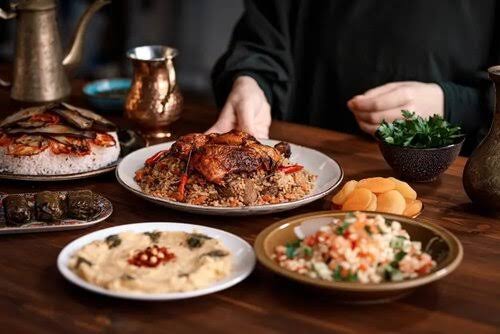Emirati food is more than just a cuisine it’s a deep reflection of the UAE’s cultural identity, shaped by Bedouin traditions and global influences. From the warmth of hospitality to the flavorful spices of each dish, the culinary legacy of the Emirates tells the story of a people rooted in tradition and pride.
The UAE National Dish: Machboos
One of the most iconic dishes in traditional Emirati food is Machboos a rich, spiced rice dish prepared with chicken, lamb, or beef. This dish combines long-grain rice with a blend of aromatic spices such as turmeric, saffron, cinnamon, cardamom, and black lime. Slow-cooked for deep flavor, Machboos is often served during weddings, Eid celebrations, and major family gatherings.
The bold seasoning perfectly complements the tender meat, creating a dish that is both satisfying and comforting. The layers of flavor in Machboos represent the UAE’s historical trade ties with India and Persia.
Sweet Treasures: Luqaimat and Khameer
No Emirati meal is complete without sweets, and Luqaimat stands out as a favorite. These small golden dumplings are fried to a crispy finish and then soaked in date syrup or honey. Served with a strong cup of Arabic coffee (qahwa), Luqaimat are more than just a dessert—they symbolize hospitality.
Another beloved treat is Khameer, a fluffy, lightly sweetened bread often enjoyed for breakfast or with afternoon tea. Made with ghee, dates, and flour, it’s a simple yet delicious expression of Emirati baking.
Core Ingredients of Traditional Emirati Food
Emirati food centers around a few staple ingredients: rice, meat, dates, and spices. The heavy use of black lime, saffron, and cardamom creates a unique flavor profile that’s hard to replicate elsewhere. Other key components include:
- Dates: A daily staple in Emirati households and often eaten with qahwa.
- Spices: Imported through ancient trade routes, spices play a central role in dishes like Harees, Thareed, and Biryani.
- Fresh Produce: Seasonal fruits like mangoes, pomegranates, and figs offer natural sweetness.
The Cultural Role of Food in the UAE
Beyond nourishment, Emirati food reflects the values of generosity and community. Sharing meals during Ramadan, hosting guests with qahwa and dates, and preparing feasts during Eid are all practices deeply woven into the fabric of UAE life.
To experience the flavors firsthand, many tourists and locals visit authentic dining spots in places like Global Village or IBN Battuta Mall. For cultural insights and lifestyle guides, check USA Time Magazine, or explore the food channels on IPTV Monster for Emirati cooking shows.
Conclusion
Exploring Emirati food is an immersive journey through the UAE’s rich past and vibrant present. From Machboos to Luqaimat, every dish carries a piece of Emirati culture and hospitality. The next time you’re in Dubai or Abu Dhabi, make it a point to experience the authentic taste of the Emirates.
FAQs
What is the national dish of the UAE?
Machboos is the national dish of the UAE, a spiced rice meal cooked with meat and fragrant herbs.
What are popular desserts in Emirati cuisine?
Luqaimat (fried sweet dumplings) and Khameer (sweet bread) are among the most popular traditional desserts.
Is Emirati food spicy?
Emirati cuisine is aromatic rather than overly spicy, using a blend of warming spices like saffron, cinnamon, and cardamom.
What are traditional ingredients in Emirati food?
Key ingredients include rice, dates, saffron, black lime, cardamom, and meats like lamb and chicken.
